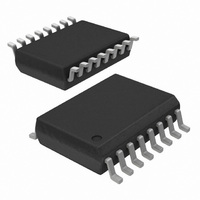AT25DF641-S3H-T Atmel, AT25DF641-S3H-T Datasheet - Page 46

AT25DF641-S3H-T
Manufacturer Part Number
AT25DF641-S3H-T
Description
IC FLASH 64MBIT 100MHZ 16SOIC
Manufacturer
Atmel
Datasheet
1.AT25DF641-MWH-T.pdf
(56 pages)
Specifications of AT25DF641-S3H-T
Format - Memory
FLASH
Memory Type
DataFLASH
Memory Size
64M (32K pages x 256 bytes)
Speed
100MHz
Interface
SPI, 3-Wire Serial
Voltage - Supply
2.7 V ~ 3.6 V
Operating Temperature
-40°C ~ 85°C
Package / Case
16-SOIC (0.300", 7.5mm Width)
Lead Free Status / RoHS Status
Lead free / RoHS Compliant
Available stocks
Company
Part Number
Manufacturer
Quantity
Price
Part Number:
AT25DF641-S3H-T
Manufacturer:
ATMEL/爱特梅尔
Quantity:
20 000
12.
46
Slave CS
Atmel RapidS Implementation
To implement Atmel
implementation, a full clock cycle can be used to transmit data back and forth across the serial bus. The Atmel
AT25DF641 is designed to always clock its data out on the falling edge of the SCK signal and clock data in on the
rising edge of SCK.
For full clock cycle operation to be achieved, when the AT25DF641 is clocking data out on the falling edge of
SCK, the host controller should wait until the next falling edge of SCK to latch the data in. Similarly, the host
controller should clock its data out on the rising edge of SCK in order to give the AT25DF641 a full clock cycle to
latch the incoming data in on the next rising edge of SCK.
Implementing RapidS allows a system to run at higher clock frequencies since a full clock cycle is used to
accommodate a device’s clock-to-output time, input setup time, and associated rise/fall times. For example, if the
system clock frequency is 100MHz (10ns cycle time) with a 50% duty cycle, and the host controller has an input
setup time of 2ns, then a standard SPI implementation would require that the slave device be capable of
outputting its data in less than 3ns to meet the 2ns host controller setup time [(10ns x 50%) - 2ns] not accounting
for rise/fall times. In an SPI mode 0 or 3 implementation, the SPI master is designed to clock in data on the next
immediate rising edge of SCK after the SPI slave has clocked its data out on the preceding falling edge. This
essentially makes SPI a half-clock cycle protocol and requires extremely fast clock-to-output times and input
setup times in order to run at high clock frequencies. With a RapidS implementation of this example, however, the
full 10ns cycle time is available which gives the slave device up to 8ns, not accounting for rise/fall times, to clock
its data out. Likewise, with RapidS, the host controller has more time available to output its data to the slave since
the slave device would be clocking that data in a full clock cycle later.
Figure 12-1. RapidS Operation
MOSI = Master Out, Slave In MISO = Master In, Slave Out
The Master is the ASIC/MCU and the Slave is the memory device.
The Master always clocks data out on the rising edge of SCK and always clocks data in on the falling edge of SCK.
The Slave always clocks data out on the falling edge of SCK and always clocks data in on the rising edge of SCK.
Atmel AT25DF641
MOSI
MISO
SCK
A. Master clocks out first bit of BYTE A on the rising edge of SCK
B. Slave clocks in first bit of BYTE A on the next rising edge of SCK
C. Master clocks out second bit of BYTE A on the same rising edge of SCK
D. Last bit of BYTE A is clocked out from the Master
E. Last bit of BYTE A is clocked into the slave
F. Slave clocks out first bit of BYTE B
G. Master clocks in first bit of BYTE B
H. Slave clocks out second bit of BYTE B
I.
Master clocks in last bit of BYTE B
A
®
RapidS and operate at clock frequencies higher than what can be achieved in a viable SPI
1
B
MSB
C
2
3
4
BYTE A
t
V
5
6
7
D
8
E
LSB
F
1
G
MSB
2
H
3
4
BYTE B
5
6
7
8
3680F–DFLASH–4/10
I
LSB
1















